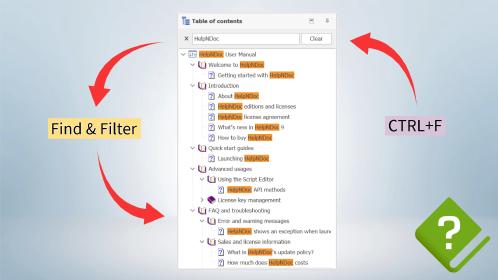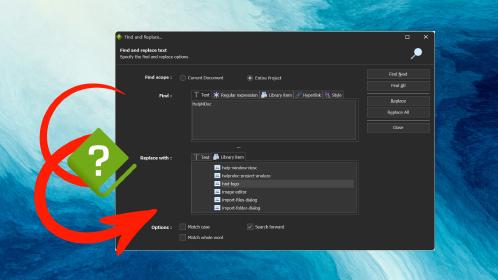When working on technical documentation, every tool and feature at our disposal can make a big difference in productivity and efficiency. One such feature in HelpNDoc, often underutilized, is the “Keep Temporary Files” option. This function may seem minor at first glance, but it holds substantial benefits for those creating documents in formats like CHM, ePub, Kindle, and Qt Help.
In this blog post, we’ll explore the practical side of the “Keep Temporary Files” feature. Why is it useful? How can it make your life as a technical writer easier? We’ll look at scenarios where this feature is particularly helpful, from simplifying troubleshooting to aiding in complex documentation projects. Whether you’re new to the HelpNDoc help authoring tool or have been using it for a while, understanding how to effectively use this feature can streamline your workflow and save you time in the long run. Let’s delve into how the “Keep Temporary Files” option can be a valuable asset in your technical writing toolkit.
![Happy technical writer using HelpNDoc [happy] [Featured]](/news-and-articles/2024-01-17-making-the-most-of-helpndoc-how-the-keep-temporary-files-feature-can-benefit-technical-writers/images/happy-technical-writer-using-helpndoc.jpg)
🧐 Understanding the “Keep Temporary Files” Feature in HelpNDoc
The “Keep Temporary Files” feature in HelpNDoc is an essential tool for technical writers working across various documentation formats like CHM, ePub, Kindle, and Qt Help. This feature focuses on preserving the intermediate source code files that are used during the documentation compiling process.
When you create documentation in any of these formats, HelpNDoc utilizes specific compilers - like Microsoft HTML Help Workshop for CHM files, Amazon’s KindleGen for Kindle eBooks, and QtHelpGenerator for cross-platform Qt Help files. These compilers transform your written content and structural layout into the final, polished documentation file.
Under normal circumstances, these intermediate source code files, which are integral to the compiling process, are automatically deleted after the final documentation file is created. However, the “Keep Temporary Files” option allows you to retain these files. This can include:
- Source Code Files: These are the raw, uncompiled files generated by HelpNDoc that contain the necessary code and structure needed by the compilers to generate the final documentation.
- Reference Files: Files that might be referenced in the source code, including medias, references, and dependencies crucial for compilation.
By opting to keep these files, you gain access to a critical part of the documentation process that is usually hidden from view. This transparency can be incredibly beneficial in various aspects of technical writing and documentation management, as we’ll see in the upcoming sections.
💡 Benefits of Keeping Temporary Files
The decision to keep temporary files in HelpNDoc can be incredibly beneficial for technical writers. Here’s why this feature is a valuable asset.
Enhanced Troubleshooting: When a documentation build fails or encounters errors, having access to the intermediate source code files can be crucial. These files allow you to pinpoint where the process went wrong, making it easier to identify and fix issues.
Facilitates Version Control: Keeping temporary files allows for better version control. You can track changes made during the documentation process, providing a clear history of your work and making it easier to revert to previous versions if needed.
Improved Understanding of the Compilation Process: By examining the intermediate files, technical writers gain a deeper understanding of how their content is transformed into different formats. This knowledge can be invaluable for optimizing content for specific formats and troubleshooting format-specific issues.
Customization and Flexibility: Sometimes, the default compilation process may not meet specific needs or requirements. Having access to the source code files gives you the flexibility to customize the build process, tailor outputs, and even integrate with other tools or scripts for advanced customization.
Efficiency in Updates and Iterations: For ongoing projects or documents that require frequent updates, keeping the intermediate files means you can quickly recompile only the necessary parts without starting from scratch. This can significantly speed up the process of updating documentation.
Backup and Recovery: In cases of software / hardware crashes or unexpected issues, having these temporary files can act as a backup. You can recover your work up to the latest compilation stage, ensuring that your efforts are not lost.
Collaborative Workflows: When working in a team, these temporary files can be shared to provide insights into the compilation process, ensuring consistency and aiding in collaborative efforts.
By leveraging the “Keep Temporary Files” feature, technical writers can enhance their workflow, improve the quality of their documentation, and save time and effort in the long run.
🎓 How to Enable the “Keep Temporary Files” Feature in HelpNDoc
Activating the “Keep Temporary Files” feature for individual documentation builds in HelpNDoc allows for precise control over which publications retain their intermediate files. This granular approach can be particularly useful for managing specific builds without affecting the overall project. Here’s how to do it.
![HelpNDoc's keep temporary file option [option]](/news-and-articles/2024-01-17-making-the-most-of-helpndoc-how-the-keep-temporary-files-feature-can-benefit-technical-writers/images/helpndoc-keep-temporary-file-option.png)
- Accessing the Build List:
- Open your HelpNDoc project.
- From the “Home” ribbon tab, click on the top part of the “Generate Help” button. This will open the “Generate Documentation” dialog, which is where you can manage all your builds and their respective settings.
- Selecting a Specific Build:
- In the “Generate Documentation” dialog, you’ll see a list of your builds. These are the different output formats or versions of your documentation that you can generate (e.g., CHM, ePub, Kindle, Qt Help).
- Choose the build for which you want to enable the “Keep Temporary Files” feature.
- Accessing Build Settings:
- Once you’ve selected a build, go to the template settings tab. If the tab is not visible, click “Customize” first. This section allows you to modify various settings related to how your documentation will be compiled for that specific build.
- Enabling “Keep Temporary Files” for the Build:
- Within the template settings tab, locate the “Keep temporary files” checkbox.
- Check this box to enable the feature for the selected build. This means that when you compile this particular version of your documentation, HelpNDoc will retain the intermediate files used during the generation process.
- Applying and Using the Feature:
- After enabling the feature for your desired build, proceed to generate your documentation as usual.
- The compilation process will now keep the temporary files for the selected build, allowing you to access them for troubleshooting, customization, or any other purpose you deem necessary.
By enabling the “Keep Temporary Files” feature for individual builds, you gain a tailored approach to managing your documentation projects in HelpNDoc. This allows for specific and strategic use of the feature, enhancing your control over the documentation process for each output format.
⚡️ Utilizing “Keep Temporary Files” for Template Development and Debugging
For template developers working with HelpNDoc, the “Keep Temporary Files” feature is not just a convenience; it’s a critical tool for ensuring that their templates produce the correct output.
Templates in HelpNDoc define how documentation will be formatted and compiled, and fine-tuning them requires a detailed understanding of the compilation process. Here’s how template developers can leverage this feature:
Understanding Template Functionality: When a template is applied in a HelpNDoc build, it dictates the structure, style, and format of the final documentation. Each template can have unique behaviors and formatting rules that influence the generation process.
Debugging and Refinement: With the feature enabled, compile documentation using the template you’re developing. After compilation, examine the retained temporary files to understand how the template is translating content and structure into the final format. This is crucial for identifying any discrepancies or issues in the template’s code.
Iterative Testing: Make adjustments to the template based on your findings. Then recompile the documentation to test these changes, using the temporary files to track how modifications affect the output. Then repeat this process as necessary, refining the template until it produces the desired results.
Ensuring Consistency Across Formats: For templates that are meant to work across different formats (CHM, ePub, Kindle, Qt Help), use the temporary files to verify that the template performs consistently and correctly in each format.
Sharing and Collaboration: In a collaborative environment, sharing these temporary files with other developers, experts or team members can aid in collective debugging and development. This collaborative approach ensures that templates are robust, efficient, and meet the desired standards.
By using the “Keep Temporary Files” feature, template developers can gain an in-depth understanding of how their templates interact with HelpNDoc’s compilation process. This insight is invaluable for creating high-quality, reliable templates that enhance the documentation experience.
👍 Conclusion: Maximizing Your Documentation Potential with HelpNDoc’s “Keep Temporary Files”
Throughout this exploration of HelpNDoc’s “Keep Temporary Files” feature, we’ve seen how this seemingly simple option can be a powerhouse in the hands of technical writers and template developers.
Whether it’s for troubleshooting, version control, template debugging, or understanding the intricacies of the documentation compilation process, this feature adds a layer of transparency and control that can significantly enhance your workflow. Remember, the key to making the most of this feature lies in understanding its potential and applying it judiciously to your projects.
Intrigued by the possibilities of the “Keep Temporary Files” feature in HelpNDoc? There’s no better way to understand its impact than to try it out firsthand. Whether you’re a seasoned technical writer or just beginning your journey, HelpNDoc is accessible for everyone. The best part? HelpNDoc is free for personal use and evaluation purposes.
Download HelpNDoc Now: Embrace the opportunity to enhance your documentation process. Visit the HelpNDoc website today and download your free version. Experiment with the “Keep Temporary Files” feature and see how it can transform your approach to documentation.
Stay Informed: Don’t miss out on future insights and updates. Make sure to check out our other resources and stay tuned for more tips and tricks to maximize your technical writing potential with HelpNDoc.
In the evolving landscape of technical writing and documentation, tools like HelpNDoc and features like “Keep Temporary Files” are more than just conveniences — they’re essential components that empower you to produce your best work. So, take the time to experiment with this feature and discover how it can elevate the quality and efficiency of your documentation projects.
Want to create great documentation?
HelpNDoc is free, fully functional, and easy to use.
Produce your first multi-format documentation in the next minute or so.
See also...

Why International Characters Break in CHM Files And How HelpNDoc Solves It
Publishing professional-quality help files often means supporting multiple languages — from Hungarian to Japanese, Greek to Chinese. Yet if you’ve ever generated a CHM help file and found that certain …
Read More →
Master Your Documentation Structure with HelpNDoc's Powerful Table of Contents Editor
At the heart of every documentation project lies HelpNDoc’s Table of Contents (TOC) editor, a deceptively simple yet incredibly powerful tool designed to streamline content organization and increase …
Read More →
Mastering Content Updates with HelpNDoc's Search and Replace Tools for Technical Writers
Are you tired of the constant struggle to keep documentation consistent, up-to-date, and error-free? For technical writers and content authors, managing these challenges can be a daunting task. …
Read More →
Transform Your Classroom with HelpNDoc: The Ultimate Back-to-School Tool for Teachers and Students
As the back-to-school season approaches, educators and students are on the lookout for tools that can simplify content creation, improve collaboration, and enhance the overall learning experience. One …
Read More →